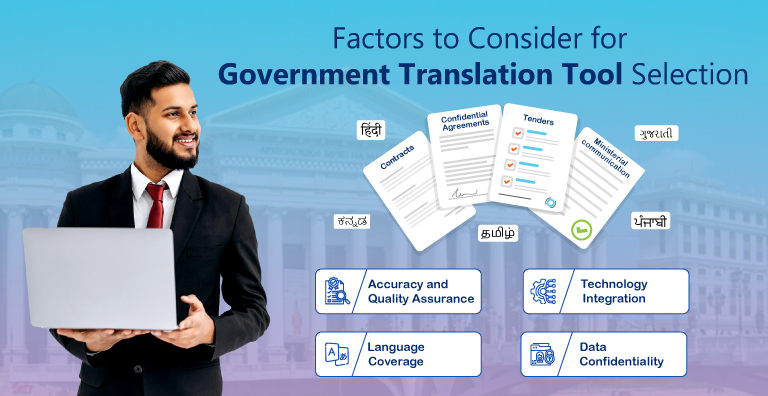8 Factors to Consider for Government Translation Tool Selection
From comprehensive linguistic support to the implementation of the tool, here are eight factors to consider for government translation tool selection.
1. Understand the Scope and Purpose
At the outset, identify the type of translation and its purpose. For instance, in some cases, you may need legal translations, whereas in some others, you will need translations for administrative documents. Each of these translation types and categories has its unique needs that the solution must fulfil. These also require a distinct expertise catering to the unique requirements. Thus, while assessing the solution, you must check for these expertise types, the volume the solution can handle and how frequently it can provide the support you need.
2. Accuracy and Quality Assurance
Accuracy is paramount while dealing with government localization. Again, the type and purpose of translation come into the picture. For example, there could be a need for translations for the healthcare department. In these situations, you will need translations to ensure technical accuracy and the use of the right medical terms and terminologies. Similarly, while requiring translations for the art and culture department, your solution should provide the required linguistic and technical support to ensure accurate translations. In the case of critical translations, you may also need the help of certified human translators.
3. Technology Integration
If you have a substantial volume and the frequency of translations is high, you will need a solution with Translation Memory (TM) to ensure consistency across all the documents and reduce the need for manual quality checks. Furthermore, the solution should support the combination of machine translation and human post-editing for efficient, accurate and high-quality translations. Additionally, it would help you choose a solution with terminology management to maintain consistency across specific terms, particularly in technical and legal translations.
4. Language Coverage
Linguistic coverage is fundamental to every government translation service and solution. You need a solution that covers all the required language pairs within your context. For example, as some require government translations in India, you should look for a solution to support at least major Indian languages like Marathi, Hindi, Gujarati, Marwadi, Tamil, Telugu, Kannada, Malayalam, Bhojpuri, Kashmiri, Dogri, Assamese, Bengali, Odiya, etc. Having expertise in the less common languages is also desirable, particularly if you cater to those regions.
Furthermore, your translation solution should understand cultural nuances and regional dialects to ensure accuracy on the cultural front.
5. Government PoC
Running a PoC would help you gauge the solution’s quality and pace of translations. Thus, you must emphasize doing it to determine if the solution is apt for your needs and whether it will serve you in the long run. Additionally, you must check if the solution can make feedback-based changes or tweaks to align with your requirements. Investing some effort in it would help simplify the use of the solution and achieve optimal outcomes.
6. Scalability
Another significant aspect while choosing a government translation solution is assessing if it can handle larger volume requirements, particularly during bigger projects or catering to emergencies. The solution should ideally adapt to your needs, languages and any additional requirements within the translation purview.
7. Data Confidentiality
Many government documents comprise confidential data, facts and figures. While translating them, the solution should ensure data confidentiality by adhering to the required data security protocols. The provider should have integrated stringent security measures and authentication procedures to keep the data secure and restrict access only to authorized people within the project. Additionally, you must verify the translation solution and service complies with relevant laws.
8. Budgetary Considerations
While assessing the translation solution, you must also ensure that the pricing model is clear, transparent and devoid of any hidden costs. Furthermore, it would help balance the need for superior translations with your budget constraints. Usually, government budgets are tight. Hence, the solution you choose should offer value for money and shouldn’t incur any additional costs later on.
Linguify – Best Government Translation Tool for All Your Needs!
One of the revered solutions in the translation sector, Linguify is the answer to all your government translation needs! It is a thoughtfully designed solution with comprehensive considerations of the translation needs of various domains, including those of governments. Some salient features of Linguify include;
- Support for over 200 languages
- SEO integration
- Data security measures
- Website change management
- NoCode capabilities and integration
- Content capturing and selection
- Comprehensive translation management
- Translate government documents of various types
Connect with LinguaSol for Government Localization and Translation Solutions
Do you want to learn more about Linguify’s capabilities and how it can help you with various government localization and translation services, including website, mobile app and translate government documents? Email us at sales@linguasol.net.

